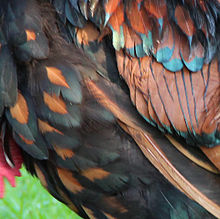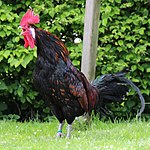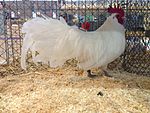Bergisch country fowl


Bergische Landhühner are domestic fowls , whose breeds originate from the Bergisches Land and are closely connected with the region. Due to their rarity, the land races, together with the Bavarian land goose, have been declared " Endangered Livestock Breeds of the Year 2001" by the Society for the Preservation of Old and Endangered Domestic Animal Breeds (GEH) .
A common feature of the races is the occurrence of the double , a very wide black border of the feathers. This drawing only occurs in mountain chicken breeds.
Bergisch chicken breeds
The Bergisch chicken breeds include:
 |
Bergische kräher : the oldest German Hühnerrasse (first exhibition in 1854), because of its exceptionally long Krährufes to Langkrähern is expected. Its dwarf form, the Bergische dwarf crow , has been bred since 1925. |
 |
Bergischer Schlotterkamm : a breed of country fowl that was known in the past for its good laying performance. Its dwarf is the Bergische Zwergschlotterkamm . |
 |
Body : a breed of country fowl with very short runs . Although several color varieties were created in Westphalia and Saxony, the origin of the breed is believed to be in the Bergisches Land. The dwarf form of the body, the dwarf body , was already extinct, but emerged again through back- breeding at the end of the 20th century. |
Differentiation of races and their varieties
The breeds of the Bergisch country fowl are exemplary for the subjective, artificial differentiation of poultry breeds.
The black Bergisch Schlotterkämme and the black bodies come from an initial stock. The genetic difference between the two races found in the investigation of the genetic make-up of the two races is very small and can also be traced back to different crossings in modern breeding, since the Rhinelander and Minorka bodies were crossed into the Schlotterkamm but Castillians . Outwardly, the body and Schlotterkämme differ mainly in the different leg length, which can be traced back to only one genetic makeup.
A similarly curious example of artificial systematization can be found with the Holthauser chicken in crows and Schlotterkämmen. In old sources, French works of the 19th century, the Bergische Kräher ( French Chanteur d'Elberfeld ) are described in three colors gold, silver and black. With the first standard for Bergische Kräher, which came into effect in 1885, only the golden crows (or the black and golden brown crows) were permitted, which led to the disappearance of the black crows. In 1886 , Dürigen described the silver (or black and white doubled) in the first edition of his poultry farm as "Holthäuser chickens", which differed from the crows practically only in the silver instead of the gold color of the drawing. Their independent breed status later became extinct and they were combined with black Schlotterkämme and sparbered Leiendeckern to form the artificial breed "Bergische Schlotterkämme". Already in the 2nd edition in 1906 you can find the white and colored Westphalian “Holthäuser” and the cured Elberfeldian “Leiendecker” only in a marginal note in the description of the Bergisch Schlotterkämme. In 1929 the silver crows or Holthaus chickens (almost) died out. In the 1950s, the reverse or image breeding of "black-and-white doubled Schlotterkämme" began. The crossing of Bergischer Kräher with Thuringian Barthühnern genetically approximated the extinct variant, but it was just as little a ridge as the Holthauser hen. From the golden crows, whitish cream-colored animals occasionally fall to this day, with which this variant could be re-established without crossbreeding, as in the 1950s.
Evidence and further information
literature
- Armin Six : Bergische Hühnerrassen , Reutlingen publishing house Oertel + Spörer, 2003, ISBN 978-3-88627-515-1 .
-
Bruno Dürigen : The Bergische Hühner , in:
-
Poultry farming from its current rational point of view. Paul Parey, Berlin:
- 1st edition, 1886, pp. 72–78 (digitized in the Internet Archive and at Wikimedia Commons ).
- 2nd edition, 1906, pp. 68-80 ( digitized version of the HathiTrust Digital Library).
- Species and races . In: Poultry farming . Handbook and textbook on racial studies, breeding, care and keeping of domestic, farm and park poultry. tape 1 . Paul Parey, Berlin 1923, p. 79-93 ( digitized from the HathiTrust Digital Library).
-
Poultry farming from its current rational point of view. Paul Parey, Berlin:
proof
- ↑ Armin Six: Bergische Hühnerrassen , Reutlingen publishing house Oertel + Spörer, 2003, ISBN 978-3-88627-515-1 .
- ↑ Bruno Dürigen: Types and Races . In: Poultry farming . Handbook and textbook on racial studies, breeding, care and keeping of domestic, farm and park poultry. tape 1 . Paul Parey, Berlin 1923, Die Bergischen Hühner, p. 79-93 ( digitized from the HathiTrust Digital Library [accessed January 8, 2016]).
- ↑ Endangered livestock breed of the year 2001 ( Memento of the original from September 24, 2015 in the Internet Archive ) Info: The archive link was inserted automatically and has not yet been checked. Please check the original and archive link according to the instructions and then remove this notice. the Society for the Preservation of Old and Endangered Domestic Breeds e. V. (GEH)
- ↑ a b c d Armin Six: Natural or artificial system . What are poultry breeds actually? In: poultry newspaper . No. 13/2008 . HK-Verlag, Berlin 2008, p. 14-16 .
- ↑ Bruno Dürigen : The Holthauser Chicken . In: Poultry farming according to its current rational point of view . 1st edition. Paul Parey, Berlin 1886, p. 78 ( digitized version in the Internet Archive [accessed on January 8, 2016]).
- ↑ Bruno Dürigen: Poultry farming according to its current rational point of view . 2nd Edition. Paul Parey, Berlin 1906, p. 74 ( Digitized from the HathiTrust Digital Library [accessed January 8, 2016]).
Web links
- Association of breeders of Bergischer chicken breeds and their dwarfs - Crow breeders' association since 1884 , accessed on October 31, 2015.